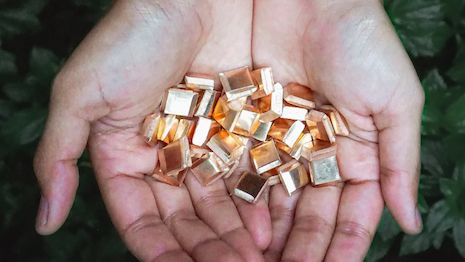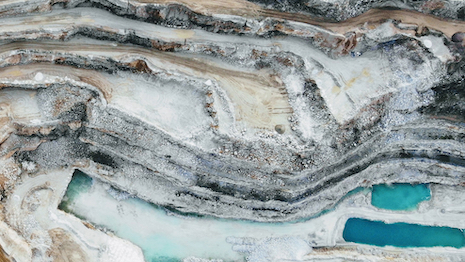Adherence to detailed traceability and transparency protocols is quickly filtering out luxury watch and fine jewelry players that may be unwilling or unable to adapt to evolving demand with haste, according to a new Positive Luxury report.
The British certification agency and sustainability resource has released The Future of Jewelry Watches, a report which centers the industry's issues, offering tangible solutions in response complete with concrete example case studies. The set of positive solutions for people and planet arrives at a crucial time for an industry whose future profitability lies definitively at the crux of luxe sustainability, per demographic-informed data.
Sustainable sourcing
Between an increasingly urgent client crisis and heightened consumer demand rooted in the well-being of fellow workers, socio-economic and sustainability issues weigh heavy in hard luxury's hands.
According to reports from Positive Luxury, ESG follow-through will serve as the foundation of positive hard luxury sales, with sustainability existing as a top purchase consideration, in the very near future.
The organization's latest release speaks to this, diving its content by topic area, beginning with hard luxury's paint points before delving into suggestions towards improvement.
Positive Luxury's report tragically reflects that over one million youth are engaged in child labor across mines worldwide.
Seeking out certified suppliers and conducting regular audits is a necessity to ensure a lack of abuse, yet self-regulation seems stagnant in this area, which appears opportune for strict, no-nonsense industry standards and enforcement.
Ongoing illegal resource extraction plagues the land and surrounding communities – deforestation in the Brazilian Amazon caused by illegal gold mining increased by more than 90 percent between 2017 and 2020 – not to mention the industry is eating away at nature's finite resources in mining for gold and precious gems.
Each karat of natural diamond mined industrially costs the landscape up to 250 tonnes of moved earth, 127 gallons of used water and releases 143 pounds of carbon dioxide into the atmosphere.
 Cupped hands hold fully traceable, artisanally mined impact gold from Peru, part of a sustainable, transparent supply chain. Image credit: B.P. De Silva
Cupped hands hold fully traceable, artisanally mined impact gold from Peru, part of a sustainable, transparent supply chain. Image credit: B.P. De Silva
Though industry players have proven resistant to innovation, tapping alternative, lab-grown material is an approach that does not have to render traditional diamonds obsolete. A moderate balance could work to control supply and demand, thus improving the volume of extraction occurring from natural sources.
In the case of naturally-mined options, some groups are making good use of Web3 technologies, in the fight for traceability.
Founded in 2015, Everledger is an industry resource that uses blockchain technology to create an immutable ledger on which the supply chain of diamonds and gems can be securely recorded. Higher, more widespread utilization rates could secure hard luxury's sustainable future.
Speaking of, natural diamond trade organizations could be onto something, in leaning into the heirloom aspect of well-made watches and jewelry.
The mantra is captured perfectly by, for instance, luxury watchmaker Patek Philippe.
"You never really own a Patek Philippe," says a company tagline. "You simply look after it for the next generation,” which has been successfully employed since 1996."
Emphasizing the purchase and maintenance of valuable, high-quality hard luxury plays its part in preserving existing products for future generations of use, thus eliminating the need for excess production.
In the case of jewelry company and partner entity JEM, Positive Luxury's own certification system helps to distinguish responsible sellers from those of more questionable means throughout the industry, acting as an effective marketing tool to match sustainability initiatives, especially as generational preferences for ESG-conscious options surface.
The group exclusively employs Fairmined ethical gold as part of its designs and opts for the use of lab-grown diamond options in its inventory.
Even more niche areas like pearls and mother-of-pearl sourcing from carefully selected Fijian pearl farms, committed to the preservation of marine resources, mark an above-and-beyond effort from the retailer.
“The Butterfly Mark identifies luxury companies that meet the highest standards of social and environmental performance and transparency," said Dorothée Contour, CEO of JEM, in the report.
"It reflects our strong commitments and underlines our desire to continually improve," she said. "We are proud to be part of this program that inspires and invests in more responsible luxury.”
Future clarity
Transparent supply chains and sustainable production is no longer an option, but a must-have in today's market.
59 percent of millennials prefer to purchase diamonds of sound provenance, while 21 percent of Gen Z already consider jewelry’s environmental, social and governance (ESG) credentials before purchase.
According to a July 2022 white paper from Positive Luxury, 85 percent of growth in the global luxury industry is driven by millennials and Gen Z consumers, 75 percent of whom value sustainability over brand names (see story).
Thus, luxury players must communicate a dedication to the well-being of people and planet in messaging materials, as the group would for any other key product details.
Released at the top of the year, Positive Luxury’s 2022 Predictions Report also called on brands and organizations to be cognizant of the immense challenges stemming from climate change and luxury’s role in tapping resources (see story).
{"ct":"WB8wm5BVkLh03IfZ8+JQMieAcJzVdLQPfcIzL1bvw+bNrlFKn62vk2dfV+t7H4AJG8eDNlqEEQrdhZ77UfD68z5Ltv2JsqGfLm2bU+DbwpP255U+bW5h\/\/T0dxxdZLj\/PN3JrgiOvnrOt5oiMIEkN16GzAAO5I1t5Aqt\/er3ue4Tp7cKDq9T4M9+6BYOBqkOD+JoL9d\/hiboONB1pyI\/qdy9YW+nCvam1Ui5nNWELguESz4XNc+udo7JqPmHjj4M5YAyxBeKSY6boOI1ZFda3ECMkyTf3\/R2QGcvk3+\/mzqL7btBnkav0EGxrt72hZgGmVPQbAl2DUsziMo\/DsVnxkE3pAhuyOklefWJC7MwneQfpTuyV9oRN3bu16A4PtAZJ3ubrFSanQi832qt4nnG2qNVB9OTFLZK51ILmMfacU6j2GRrh\/GajmShxd9VlrUffJF4+ToGBfrRN0Gq7EF20yCyrsDVqHDsxSO5TguTiAjM++4ZfopVqoG2TF+4Hy9SJHH3Wcclsa4yaKDOd2uyr+m1\/g6T71gK10X5YtkNC37dEyxQsU\/JUT1K9FzrrcK6H2zIpoZ+UI\/xDRCKxqCfCwWuQqD58byQkB+ICohXdmlPjuFx78m1TmHCpRXHxKL8JQMfFGNoPv\/e4AqBc4\/lwvTIscNnf12qGHnTwUV9jxqaBhxkXLfsxoPxFHajnAiu32WNk93OKYPfHyyGg1shCXh3udoZKwlrxc4N7OwfRy7EeFVBnQXK\/hmpyNd2z4BYrB13qlJFcR6FVVauWIU0ZxxQQHEv5jpy\/MkSHSVYqFXRx5DvoDIQwDh2ZjcWSbqkIm0CpkCxd5uJQp\/KZg1L+Feuc971GdBxa5TKG3SQ3ZDwcrI\/vHSLpu88N2ZtFuD\/M1EB8wjnbyBAPWk\/Uvm2sFq5tlFEpARCEXpX1GnS8LbBq+IFqGz+A+5mV2GkN+y7AefYNmJ2H8fGpjQ9IbR7wZ12YApjn3OU2Z9bKkajQjZvadClmzqWECOnTygUs3\/zeA0W+xwWfvOKtAlpqy0Hh0yzNb9++W45ZcDf3u4\/cpxILeme43NaxxnGeozBTf1Vl\/V3ZJAqO1SAGU8kFTJvWp1QB8ruSodZrx+pbBYh0LfpjMzLJlP4oYO5kz2lnBR7St4CXVlWrlJhzKuzT37bKaqKdavGvvZJrXH3lAQ+V7\/HdZHa2SEadUjriPdwST2FIernAW+RBH54M90g6\/oXPjP62b6t4PjmjaMEIwr4ZYY9jFZv8h+ZNnmf5YcqlnX\/fizZvqkn04UNwvstySpfZWtxGfsqkPrZ3xHWzTp9vtJTE0cIGtRPIKsG6zVPhK6A2F4SRVM8aIPixae17Lctrf14yJXQfCu5hbydglVBMd33u4WpiJgwKPOYqPB77gX6VE7drXEUKF74kBkPNioDnkn\/BH+IY+\/1pB3eG8muDXYsTpEbHXy2XPl140sQaZRYlw5KKzv8wHOMDiy9mcQ8VZsV\/KIe\/DTargVuuXSQJClZiHnqHglhg9STV+yFRk2w\/OC2oE1k\/lq9SJqg\/gBI7ec5CXH4sfqC7qsh3AfNxUNnd7w4KE9l\/kDisZi\/Ms5rHGGzNOws02X8kdKIdYLdl0ziLe\/ruc2O66ycB7XGYJdZrC98gsWldOqUZfl67rf9g1nnuCj6+ShhYJT5NWP3hzm6OtwMIwWN2QNyeggqNK9awwnkTVrfLdRHYjEg9GKoXe6ixgEJN7gKMCb+KBTDjFCUU5mTAOPnSKGCUPCjkUz5v9Mug1uVDzLVU2yQdUfK+VR4u85c7Y4UKvTGl27DFdnW4S2ri9JrLO4zJDpfQpqA35ArS159UKDG3aUWYFkcoi7UZ1jvg3FCv4eMkCl8eXX+GiIw1l33HNmE\/sX9Fdcpfrb4gemeu44nYCmPTkHcirTsL+t+nC0rJBi6V5MRDkzStZqyL1t3ZoE\/G1hTfcDk61jsJV\/P62uz1e5QrGhv9Ujq4hY0vBHugPODBj4mEymegBmoxVhxfWCaCanyLApMOS3WedEo8v83meAsmsXwiK4NqAGJOi8JL9dqJP45p274M6pLnOLTZ\/9UUjAomen5z+ne+n3TGkycz2U9L0i0yAXIhhQwu4J3ghI\/L8zXXYuods3tjCedT8YC22K3AwI0RwEGIxsr9pLJbW5CgkSq+JpPvsCkcAc4iViVUeQFMEJ4J856TA\/Xxb9\/VZeNa7DTvYs1Gv\/6P0i73QQZZ7TrYXSz6Mny7KYLOSTefmsuOoC7TS3O8RwnmbxOrU6uxKi4og9Ct0ikvzeVzXw8PAd9mUN9LdWzeRs7sPalu5SstlpkSuo\/sV\/Aaq\/SH7Mw5lwqfkM8utfaohhhEa98fbFNFaKt\/68xFJwv58ps54DFuxrxVMShAVkS8J3vIAbfnesns9AO4g6fp\/yXRZaZcs9SodQxeoe73Hv3X15zUS7F6Oy1UFOe5CSrCJfZgmN7Z2hk0FTD7aQu5nrtpR7xm\/Z0c3DQTg5YmSnLmU4zanTOgL5EtKRvCfnRCB5UtwLxJg14Ro3fSwXJYIHndiUGX1VvvYtkKi48cthe+bqjaEJXKz4r56wi2+h\/apWnepZbomsfSGPOj1CuMdt1E9E23dkyjq1ISX3jNM10g2+afCioOXO9yLpQjJ4BzR6wkM6GyYwoChlUy88BWe5d+Fprsi59c1fRXOfT8a1c0SI04pjTT1999v5aioRUQLZf6PB8E4GYgq2rCCiyapKD1Y6ldH+rD0PhnFVfG8kE6mjthYZj+pN9Kx2ytgN3asM70E3B3PgXCSD6G5zQkwiHiTxUmxDSOysfl0PCUnZhSwr4SrUuDzI+q36OPvb4C4MkWS6viNr3r2dnRpWdMFq6LfoqlJqCd6HTr0qhCfpU2MZbfZbfH28MdGLlmhFwsStXIEwyd+\/YAFSGeKtdf6HMs\/CSNgPRSUML83HXyTjKvZXMrYS43UWaRwWaelLf3oyeMoSdW1U\/hRRfuHj\/JnPe3lpV9hTSB+zAkebzWcW+AfHkkL5wwtAyGMXd987\/VNS2BaeiozG7LcmOAAwulP7EUgfmIPO4+Xp3nSb9YHaB\/YxFwuv2iPrnFjnlqCFRgAJwpKHUJfpZu6B1hAdAqWS9SFp1if3neppUrun6pi7mlP9RdTqPUnFwVAYm3Nw\/v2Z6ngJf3Spei9TwLjfQZR9m9iAvAQ2wLUY02yNzoYISSOQqd1T4zxRH69Fn3U8lcY9ZUQfdWKT7M4nLOPG7qPJlWYMjUNy7ypguycXqJ+H91QPMcpPVucTM+i3QcWlPuxUjQ9prKw827t6EYJhaENGHX9vy6tiEQvgB1XcTOFhQh0F5SE16sm1lcA65juctO0uaJjluQ4z5WUjWh15aFFhfAr3ty\/CFOT5zJ+ORBCSN\/Lg\/n\/eNw0TCIEhtQYfuRNat2xT3YMYsfHPb7wFgTpleigmw6J+oLLStBniB0fqpHdW+pjPeTv6ja9ZyiDJByOmfoslIp0OJadtcD+8RFkUOnMwj5G4T92eiM0cGchdTN3R\/MJYBu3BYsqOIz2x2asTGIgpzo7Y5OAD1Cv+vg49dy0jAJ\/r8ftmmkU+m6299TZx\/SdV7OFI0ylc6nBxxVB45ANambDJb76G+1iJTeDBSXOxZsrpZN0clGrA5RQqxRKfXvt3cZ7G6DevegnoqqlRcHl4ITjQyE6pa1rlbyVjsnvDd71x9hcx2KbErSo9x5qnv2ahHEQQd2fuTfyn2WxqKThn9pTIWoENXoXf11jgcZNZmVYULe7mVO5mx0UAb+hNjqarmr4bt59esmuCqeJH9+Eo7aSUFJStnYuNvr1ZlLQtdhe0ASRl28a8mC+CxXq5SNfBmMYigLRjYvZIU3z2kM3iiPBWH39BLRK81JTGK0X4XhQiin7vS6NGXzDC2dMEcsJdwGd4jjwOSrUM0uRYMapqIGey4sKIE94TAH1u41yIGUp+jaVG8leO7vhAqFhqW8mIs2Z9pqoM5IaUIQhShfZ5Anz1vWVK7Uk5ELXsIVJIiDkkhGgfOMPn0qfNY2fL6wi5nRFhr6\/XBa5hMFiBE5FWh3a+bWEHkLviwa+QieICpzlyMh2GzLYQEob07FkGJPJPyce9t+iCz04IMna\/kh7k9Y8RZpv2VEVNOo5bBKbRtRMKkf\/Aor+p08BRArT7BUgBxBzWMx6nPYOr099a+yHS9lgeM4tdzA1t\/PR51U07RU\/8fWHAm2P+\/mVDCWyYvgBfVLNEzoX+ySniME059Z8\/AGWvQmFFqFCKjNfC6oIIt33PjkiuhY6bZ+VUsB4K767qBWOxmbdnQuBy7y5CsW6hCxNvP2QqtkVJtHgvpM+UTMwAiXg1R1UvQn\/uIr4NVJZAgqifDYIxtsS8oWGZ6o2C7u5JbTDiLZukCbQLVFUz74Ye1JQXGKVz\/QBzwhe96D3zOMcC9zhJkHWvQoJTTgPaOmk16SPG9tVljHr\/x4FzuVBh82h2UP4NaRHCAMFNI\/q1x1WnSBqEwCzDILouUQLYLlwHXNONh6SiYInjHX8HSAS2aJRnzGgYdRwVdni8Fqrc79aHngOuFm+XMI1G\/sPuK3S1P4cqWSWjCWE+TaVwibQmiTFFlBzb4pjnYgh5e9moEAkceU1adOBIiUuSuX0iDw1Qfrl71la2o7rcOrv2Iv7oB37ebTXDpEhAh9bh68tvQLBpi859XVAHjBrKIKvgGDDuM8TZslrhZAhotU9UWCnHpu7hzVU3MwGLUofChxZyzmQ25j6KZojudi6inafWxq1fPTIzY5XDEGBYYbvsT5nUh99xC7FS6aCYUmHTVOrMY40jE3xWYlsCu6jCYfoTPh8CjDlPlvfPA065gKhQsYmBPomTgjo8oIitMvR9m58CWSCXSPPXXw6O6MEIjLLeFj\/pa6qnDD2kWKZ3vk95Kmf3Mf6dhfpfiGq1VdqC+B\/17U8X7J8Fxhr\/qwbUfEOBFLMpuL46tCzpHvGm5RsQ5RZbYt3cwy5BUf3TtogreD+T6kRcG7W4EZN2wHLsjLfh3IQlGZYIFN8KLE8Z4MkfXgFWemKFHyMk+vQmUEve8OFlJGCtLeZi3QbcKsTMvJ54R31dhmjtlDYc7WMOuRW2bOD\/sYtNO7N6LryMzzawWSR2fjR5RIQ6EGMeSNf3qOkSEdSKDEjQ2SzRYJWZgvKvXIYeeDpndA0XI56Vr3awFP30\/iw16zOjF0vPhDE8OTZU9hwwaRIxasyQjwmqUhKqnbfyZUs44z8TMlY4nUZprJdClbfJBVdy0t5KjDOvwuEeCrwFGDrIEQ3PgCp4vyuqP9gIBTVR79tG4XB\/ytPl7ZsNonmrJlVAF0vXstCrCJTO+oSTZXJi9\/KpY79\/r4HxnMZa8cKnDQualWM376ldHZNWE9rzUg0gtqY\/SkpdEjx9WSKC7Ee5bfDF4kUgTUGQoQk4VwBzDRSWvGfmasL8owIGj6Ab2R09Lnd8pMfVocm+G+J+SYiTba6whXH7LTAfrYtK6Bg72cj37Bq8N75+rWly7bx7CXtZxln8RqnxJWBL+XXbN+Z2Yht7LtcCnMt9GWxT0phD3vZResUWd6esUcxe6q7etZC3O8yA4zxFKulolQ2es2ux4+YL\/GRcVDdYiY9t8Y+tTMHDecECAqW3DV5CaZ56BFdXJmZXH9Yv9em4y\/ouQr6ubw0d8ygK7+\/7qrvCn0fVreNdK0ol66\/1e2+I8wr5blCsksfK8L7Ud27YpeW50HCOu9OVxas6mkvGeC7RaOTummB0pgjQ++YQLPEig6\/uY\/auQueVwTnfKaPdLymJ\/1bTa\/CzLerF0vGdNRjAqa7TJ2K6M8LQ2k7feC4SthUGrhGOVkP8iGXmdNu0iGc0DFlGwGwyUeYYa49oaps7iP5qVcGwdRyxk4xXefYzQM5cjYoCHW1iZgMkQU96BFrVJKT0JvDQHkzbw8wM6ddwRfpKLtTlSzjXSr7evsmumgif5u1WddUftJGTgkQbPUDlC+Yt6O99CqmLZjFugcpL+eETQBxp1QumZo8ypWxq8a2yQ5qNgIKMfix\/bpIvdU0T+0drubD2JCRD8PxwrJ6\/nxYbo\/7bx28HNUZxYoQr3hTnigzT5xcEfdo4U53Ex+OMPkta+vsgsvFhOfkYMF6b8FSfsU99UwKvKYKCwOmsGOk6sSPLyaHnTpAtmgKLYSjF32sRWSrXT7bhaHJE7qe3R1+yENO9NhgF9xd0Q2VKabvdNVYGgnMOMnah9ekwobZNeTjKQxuf+1R0raMx0nRRRhS8+5K0ltrUKKCuHNMMSxpmQ7WkUoCtdtChVY24utQBh5wnXujMffGl+XMRzRqGsnWn6x6Nylb9jO4TLvHUnyG8ru2ycmv08HrIidmkZCXX0o1WFx6xOtHyNGhVMndo9watFKzGCZjwZv6RAsSJ2XQYdQhmc4zmgwhN0Cf9tKgAQMiP4yhD5VmpZl2e4YNx9VAc2cjJZ07KYjWQkt\/8hY3nKqas2hrZj\/rbmZ0LkUVjdtkU36FVYcCvIbC49QMJZHYR6hs+8cZRXzguFQCXSkXl+veGUh4oBpHgZTircN24nhA8LJwrDEI0esM0jcEDv+uXW7ke73I6KflurbOF7Isxhtf2JUcWbgwwQjDqBaG8eKXZipDEnOy7V9DWUi2IBcvBURmF+Htl4cBJ4AZfIJRW897g4RGlJSTlelCiCayX0efElsYrZKOQ3vnXU8gqei6RJpUKnaOtSqx9w7olv4NuvIbHWwWfXId+o5oDORu28u6HihoSBomuol3Y7MRdRLE8IGIBbpFGXZe1vz0nYz6Ha1lGXMkgevYGESCxkBkBP+xcFTAcm3dWMisJRds+HaOarO2e1GYn1acMgpR6lJtWOvY22wZ90oG5Ft\/Ru7PCv9l4ajiUJj3cQOfCfuLeUMyw1gMSVTgAHeSjTQ\/ntUuO3BhrMie7G05WptORe+MyG2F2ZTnup1ATXwC1j360uaHs17E9hk+qXJs7nbodvcVgo4\/bWjMTxk7PpXhqS5YH0tysZ5dinMiBiRRcrpqyYt2r+Ywg4Iw0LemsbiQddvSZXxlsy7MnipXtxyCPqtsgUhVrwel20XbBuR\/vvAS3Zhom9oLXFKiQHYLC0IL3RV5TluXuW9LRwnmXYQj6rkZb0PgV1PjU2u0Y6vfkujs9e\/piMLNpFNVfDjXH6CASWZJfEoQgUn3kyp0YMTlWlVET5C0YGH3QdLSixAx0PhxU5Zk51daPegeMg73Mmarc9X9U0gLx91sTiXRKg8QfLzThhRAHU7mjSNNzlUVC3i9pC+pSLsMq6zjOBLKlwRuenTGBUDrEWpdwvPAb1Pepc9XzPMgbuxR7ZhZRTdUaTo33F3wGi1mDBOvSdUVxkZNOcdfYWQejIOW\/DpabVL2TvW\/uUOTRB6xSMufT8CHZYH5d6l65Detose\/XRToBMutzl0m0L4fpkI8ZvqD2bI1dLBarMygMCyRk7aDtCT5pC+UAiZghSyU+Pk\/MAnurVqM7g2XbEhkZg3LBI1N6A5y6UY509SEzbxVeI6CcYsEsm68Y7oyov+wHy02ANwByKO9rZ3rxKS4NUTzzRBs\/dD3u4+squojJZV5Ke3HyNVlejJjxE6rht0yaZDgECoPrr0D+y4+4dqaDiD3mYLK5vg+D1L\/cgdyldpRTVzecvo\/kmtGucP9EMlvC45tdKjusFsvE25Mu1rQot5\/WsFsrQEYkGvNvOD7Je06ilKow2cL6mPb7tpiLSdRde\/e9CeOt+Mn++T7pBc0nbMyzg+4o1SuaJyX\/dJdNP6mXH8C0u58Dre+EMzyLtchjuqNiecGIPmX2dJrb+0psmgrlvGGoSvCeqv3gEfA\/MZnGnHRhZiivc+w8pNaP5WTlKjMIL7HgmA7Us8eUkOyayFv4ow2BI0QxdKXwblOC6j4q2hjDL6WfuBIsIS+NTLlc+FpNP3q34DUGCbZ7uYHk8nxHgCz+DHN7\/skAA550JaMmh0O3dzVV6sce2O5AAjKdKneAuGvDl8OT2UEkmyu8S91Yu7DSIDJpr5o93L2ckwUfxlzGQYvLHiYXiGOLW7pbx5GuZSrH+NPpd2ysecSMPgSHR462q9Li+cTi8HHHFOXYbG5CquCLfzFW3Qu88rA4QWji7dtdPifJKrU\/c3QXxzgVS5HWbFELGv9cxWBQ4huIxtt0MmHnA8\/eF8SIKdqbMsRcyATh2vsW2R3h3mKaWhb5Se0AAJaH8vVnyikGK491hJU0HdVte+NOa7VJ011bGQ5jyiXzeFjEZyYqYBBLVjbIGNcsd9NMaQnOa\/koijFu7lf3SIRtXswdU0\/RAnWpRVejpEu1knFICWse3xmAan3daiY60PpmiVGJ5Zqe\/VrQEXSPgcGferiOhOxml5bBMSByriJvJ\/Lu55qRHriVhBLspM8ReecRbdlNSvFILoTTZPM\/TT1EawfuF1u\/0bfxuUe1FNSi1SbuENvP5kg5P5Wz3zmStZJTTRUP35ZNUMXLzLErCoFsbrYVuId2qgAx\/YjoXzDD+hY3R+IqiErGdRbcfDXOGu9j+YFJluW\/7YXsd6lprZ4b1p825Bv7TuunlpVqZl1yCXF+\/bUr8v41rXkBselnLmsRqQjl7x4DbyozWYovRG0ugn9O3fT58UgdRxX26ml6k1+odoYFhrF+EYHLER5BvK+T8MNZZoFR8QL+lCY2yqkQHDGxb3JJvMTtBA6vPCpXtUmHORljtypHyQuXijMRneN16fXJP51LzSGelwHraq8SnA+fFW8ZTbqTQvfBu5RxVYzM3mCWMlPN93KSq5oVct4gcUaxcwP8ebH0FvTi9WX1dCnunjUPcu5pNiqwk1m2sXY7hd89Gz7w4eDzEXenrTWlSoLDo9FtnGfVdLNap8nyosliK4OHQBmsNHyRKR0RT0foRGFnOI\/69VsAyrHCMG4swxh7A6kDqq\/Tk8w\/Hq5soEmSoUV3ew1VBgq\/1ycmO7XdzH6mmqQAQAA4vQ7v1SOjyuWNoYyzY5TFVhRcZtIVm1WPwdcLOfEIlIqhvycVmzfPX9FZRTIev1nRuzM6ZjhBOxE6i40SKrUP9S0lN4to11vR7pBLjTa+2Fx\/4L0R2HB8COj96A+6xdV69DXn1a1xA8PTEkIM98tA5c2Y30kseuXQhBCcrbzxRT\/dTKhkTeFKps0VJie9g+w6IXseMRAX6ShMrtnv0cqv1XOPKojAVrE4F1gumhDdzGChNWfynaLOxhDaoYVTfT0QU7pTWLGWM1AiARp5qRyY+47q9qMQLF\/hgbBfnlaTr9Ol6Pj9E\/UtckBhZHgqV9n9jdXTC2rOqKyNvw6KMYhxuTy7NnVhkeCI\/gB44KKbocvq+UQjBdyEvqK5EWrXW0q7RAl6uMf7X5rsvW8Xk501UJyHj2gCSBoUpeTJRWtG9WjPuhNeSuv5GYycZBRzOl1LfG51TClqQtEzqdHvPPHpFXcA7mqfME1ca5o4UR8ha5dEQHgS3kRHoY9eTcuN\/jDgKPH48vAX+v1SI4EhKMUPV5t3a0NKWF8j4JZZmwMZjZX95lU1AnQwr5npbk+twVMyTyn98JB5oRg2gB3mwH68ROOM+njXbrGviaiYHU4BmVzf2wLGDkgFeytjFENyH713ZYssR4IjdNWaKTDHrSK1ODmuGVcuCvrKBaNol5pji4KwFZRWYtFlY3gXxV6bix9Ag7EL4XX0IWIlHu6ND5J4k3X\/3aQTiyImfPB+MdcGTO5\/RHhM7X2tbZNQp439RNxPN6Pv4gjNOItsZsX\/qNkmRvmp4Tk715crRQGu+\/p9\/c0dBAW6Kap0RYdABd9rvroyCC4dly1BSGWC4DgX1SZ4CvHdSw6Pr8338Bw5SKCzA7uDMIGZTWT1RqXD38169sGGFJ2QHl5d0xPK0HpYLyxD3FRYurd7RH20nz24OhXz1ce\/\/MMXUSvfCs1HOLtvQjJCCkrxlMfWRD1h0+za0IcBsQuVrpSAAbzeojUyuaqnyeR+LRbfo4C+YawSOv7VZNB5Y0SQ2fg36u+kfVpfagJZqtFtAYalhdSvC2+f3zLfilsMoMjjwmcfMZxHpGrLNW9EqhmMHvSxT3C0+XZlp81S6rRNPpaOlFXNcsnc9l2RpaR8KHfALeCRPm1EbnuQQJZVOcwnlerMu9xqbW\/7FzX0XGF2MUTq72a5veGZq11tOHYUtW4QQ3oeWa+pB5PDqa6ExUw+1LnmZ0yqfZalJnjdlkHzjRpTI\/j0gp8c4\/+SomOCf0rQ9HVl1cvXAdMVxrmCyqVx8xuOYaRC3ahV+LlPstcSk6egD3yqkHr3QbqkyUDZK98Rby\/d6OdLZKdFM7Pofp4nwMr\/XdsaEkIz9XDqYeG0a0Ps0esiOom\/lF1jFz3UzbR9ECD8LmdQwRluJKYCTBaS5bHVqbgmp88Zt3ln5BpLJHxPsFVAGuBvGW2\/L+VGUV\/mN1M\/jylX1S31Z9FPVeeX2PdJmKjpaOk\/jTsyLQhmHo0g4LUx1FqCa\/aNRhSK9DDeSqgUlZqYAOfnuMaxsWgtP7WdbixLybeqdFeQMgY0drZfaTNePXKQEBPvWl7+GJlhq0lKfya1Y2dgNvkHOsaFppR2FPqv0QXxmo2P2oM1ebXHfPftHa+M6nAlU90acU2GfZ8FNT\/ekdcrYRkYIr5yWjorj2n3TxEWD4YXcAwpldFkFIvJdi5fOJ8miIxDJK5HeYZbzF14Ya5E9Do26b1mtDrXO989emz0+KWstfY2Yamk4yb7THPL0P+5\/2MZbDSi2ZcSqMUU79jEYzQpvIP1ynkXFT2ncvqDKr2KgMHxwQ6W4Ee4upzxXYJ6SyuXTRNhEn1SZLxyaWucgGGgDoKQJ8dyEC6Nzlgm4hKmipgPqHsQx\/qcScqsGjpyRZ\/gCMODlS1MIB+fjowU8hKjw2Ig1H\/FlYWDFeHRzdUh1gmqPdpjrnBJ+4fKTXq02v2dGjODUx3knrKFoIImH2RzbA7gSK5IlPhuHKf3ptaWW++xbC5t2TTA\/uf9r+noisODjMS5D6EpdUWSOjM9fJVxtyuhdf+M620hzqP\/qrhB35py5BZhEHN2r73QgiekgcZf4BcJ6sqYhWMSXgseEcjE\/6ghIMm3D3s6mMtu0f494wTCOztFvyxi83aZk1XWG7MGWlqNh5DMuELundbIhUXN5u3tfeHmA7RrwnJnfJB3q\/Sn8NU1vSklPdnqSpf6fyxYfvlV2LweXnEU2MnbBaNiH8mmICyhaHvNsMz7lBKR+Xr3ZybbJXQJZ8JgvaUZSTQPhNkr2lGz+ueThKGstOFQIG1O6UE+PFNXLsCTmWLCzGcQ2oV6rKXE7RsjCmK6t2bJTcua6pqcmIh\/mUEBfMFmN+9AjgWGheVyzIG9HT6SQevdAlmHjkZrZKa8okBASbP8bJP4bwMBK6I\/kihkgu8PVRvWLG6T+pCHa+pMqI2xN+nvju75ebal6UOc22Nq31coz73E\/NIWo4za2RXGl\/Tti7iPeuM1Kj1jHvSrt7g7Iyf7IZ13X\/AWu0trJp0i7TM8nQdEZ4N7ub7CBxKal6wOJ3RrL+aiEqoGzLdMbETNUirXCce93KqN9XGkwV707UOREME+FJAkeIybPNIXWh3iXxegZROsOvhT\/0yDpuJXyB+akZ98gLkIoTixVUwKDVH\/c99UhS05paMk40ZS2iMjh4SALdvwA6+Syb\/1lFWyXLl\/IqYzGxJt3hdeT8epkZVuKk3oJcU80wDsKN1gdQp7WrW1VjzdTSJq6ITBUtfQKBRVQei9V2Pmf7\/stXGuU0qbXZN30gPfKVXCrvoOpPRyF8Eifk14Q8SFVjIg+80ord6nRCUI6GWLn8YBYuXoF\/bQ0AvDP9aQNpEZjJQbg1lQdf6J+4tjldYOXwiSHICaKKt7M+5Wmugg0LKLDr0aASugJGXVudDvyWUcw96+nhAaScyJdBFIfXhrLlrVnpknJYzocVQcSKnGjflq6rBmclceKp5DopqOcOBC7B\/PWcCnUFKiFJvSRG6QK9DnQR\/PXVon7mG0MwgIOrGH\/4qnNM\/w3tLwlXI32mXjgOdHJr2cBuxzQhz1ulvt+NIv8j8XPxVwdux4qMvN1CPircGB0C5W9cGmXff67nk4Q43KxHywJXPknTUwK7v1Cz899I3hNmCexAJ0xVgLZt\/831L5q2n7Z7wvlncQSQYTDn7MjsXD43vcM57d6ghtScCG\/2UcNNc0+xbJxHKYbOsUR1D12jPC8cKW5Tm2It3MkUWXxlcwrAFPa9ITT35fHCSTRcUTUKLTYVrd6jgyah4olnH3xqTyJHg5NS+tNnDda4QgMo1j0E2SQz59Pbwm06e3dMcgu6M7NnFEJXHFIfTdBNlAoLk3k8Ly8KZb++w==","iv":"e7679eb4b8bde8186490ab15c6b0f0f5","s":"29a3a410cfc6c5e5"}

 Positive Luxury's latest report includes hard stances and case studies that illuminate luxury watch and jewelry futures, according to current consumer demands. Image credit: Positive Luxury
Positive Luxury's latest report includes hard stances and case studies that illuminate luxury watch and jewelry futures, according to current consumer demands. Image credit: Positive Luxury  Cupped hands hold fully traceable, artisanally mined impact gold from Peru, part of a sustainable, transparent supply chain. Image credit: B.P. De Silva
Cupped hands hold fully traceable, artisanally mined impact gold from Peru, part of a sustainable, transparent supply chain. Image credit: B.P. De Silva